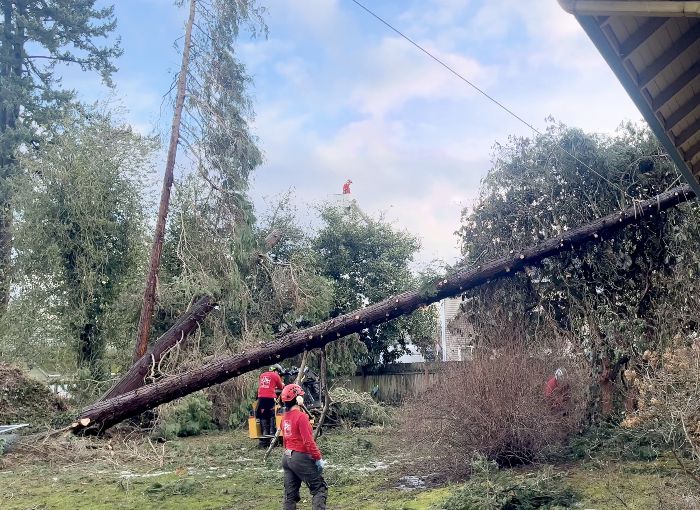When storms hit, they often leave a trail of destruction behind, including uprooted trees. Not only can this disrupt landscape beauty, but it can also be a serious safety risk. Knowing what to do when faced with an uprooted tree helps you protect your property, ensures safety, and, in some cases, saves the tree.
What to Do With Uprooted Trees?
- Ensure Safety: Stay away from downed trees, especially if they’re near power lines. Call your utility company immediately if there’s a risk of electrical hazards.
- Assess the Damage: Check if the tree is fully uprooted or partially tilted. Look for visible signs of damage to the trunk or roots.
- Call the Experts: Contact an arborist to evaluate whether the tree can be saved or should be removed. Tree professionals have the expertise and equipment to handle uprooted trees and tree removals safely.

Why Are Trees Uprooted During a Storm?
- Disease and Decay: Weak or rotting roots and trunks are more likely to give way under pressure. Decayed wood lacks the strength to anchor a tree.
- Heavy Wind, Rain, or Snow: Storms with high winds and intense rainfall or snow can easily topple trees, especially tall or shallow-rooted ones.
- Saturated Soils: Excessive rain softens the soil, reducing its ability to grip and hold tree roots.
- Poor Root Health: Trees with shallow or damaged root systems are more vulnerable. Improper planting practices, such as compacted soil or poor drainage, can further worsen this issue.

Can I Save an Uprooted Tree?
Whether an uprooted tree can be saved depends on its size, the extent of root damage, and how long it’s been uprooted.
- Tree Size: Smaller trees are easier to replant and have a higher chance of survival since their smaller extensive root systems are less likely to be damaged. And, younger trees are more likely to rebound from stress than mature trees.
- Root and Trunk Damage: Trees with intact roots and minimal trunk damage are better candidates for recovery. However, if major roots are severed or the trunk is split, removal is the safer option.
- Time Is Critical: The longer the roots are exposed, the less viable the tree becomes. Act quickly if you’re considering saving the tree.
Can Partially Uprooted Trees be Saved?
Partially uprooted trees may have a better chance of survival, especially if their root ball is still largely intact. However, these trees are often unstable and need immediate attention:
- Repositioning: Straighten the tree as soon as possible to prevent further damage. Use ropes or stakes for temporary support.
- Soil Stabilization: Firmly pack soil around the roots to anchor the tree securely.
- Monitor Health: Even if saved, the tree may take time to recover and might require pruning or additional support to regain stability.
How Long Are Uprooted Trees Viable?
Uprooted trees begin to deteriorate quickly once their roots are exposed.
- Root Desiccation: Roots can dry out within hours, making survival difficult. Keeping roots moist is critical during the recovery process.
- Timeframe: Trees with roots exposed for over 24 hours are less likely to recover fully.
- Seasonal Factors: Trees uprooted in dormant seasons (fall or winter) may have a slightly higher chance of survival compared to those displaced in hot weather when water loss is faster.
Replanting Uprooted Trees
Saving an uprooted tree can be tricky, but here are some tips to help make uprooted tree planting and transplanting a success.
- Prepare the Site: Dig a hole large enough to accommodate the tree’s root ball. Remove any damaged roots or debris.
- Reposition Carefully: With assistance, lift the tree back into an upright position. Ensure the root flare is slightly above ground level.
- Stabilize the Tree: Use stakes and ties to secure the tree in place while its roots reestablish.
- Water Thoroughly: Hydrate the soil around the tree generously to eliminate air pockets and encourage root contact.
Caring for Uprooted Trees After Transplanting
- Regular Watering: Newly replanted trees require consistent moisture. Water deeply about once a week, or when soil 6 inches below the soil surface is dry.
- Mulching: Apply a layer of mulch around the base to retain soil moisture and regulate temperature.
- Pruning: Remove damaged or broken branches to reduce stress on the tree and encourage new growth.
- Fertilization: Avoid fertilizing immediately after transplanting, as it may stress the tree further. Wait until the tree shows signs of recovery.
When to Remove Uprooted Trees?
Not all uprooted trees can be saved. Here’s when tree removal is the safest choice:
- Severe Damage: If the trunk is cracked or major roots are severed, the tree is a safety hazard.
- Proximity to Structures: Uprooted trees near homes, fences, or other structures can cause further damage if left unaddressed.
- Pest and Disease Risks: A damaged tree can attract pests or spread diseases to nearby vegetation.
- Low Survival Odds: Trees with significant decay or poor root health are unlikely to recover even with extensive care.

Call A Plus Tree to Take Care of Your Uprooted Trees Today!
Dealing with uprooted trees doesn’t have to be overwhelming. At A Plus Tree, our certified arborists have the expertise to assess, save, or safely remove uprooted trees. Contact us today to get your property back to its best condition!





